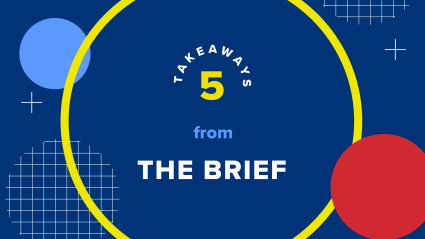Conferences are great for many reasons: the networking, the content, all that random swag you’ll never use… but in all the excitement of getting to interact with human beings in person, it’s only too easy to accidentally leave any learnings behind once you head home.
That’s why we’ve put together a quick rundown of the top five takeaways from the Marketing Brew Summit 2023; whether you couldn’t make it this year or were too busy connecting with all of the new marketers you met on LinkedIn, we’ve got you covered with the most important insights from the event.
From the TikTok titans over at Duolingo to the CBO of Strava, the good folks over at Marketing Brew got some really impressive and inspiring experts to share their expertise on the stage. Here’s what we learned:
1) Brand success on TikTok requires listening and learning from the community—and a lot of experimentation
Content consumption on social is at an all-time high and people are using a whole universe of different platforms to access it. If you want to reach your desired consumer, you have to meet your audience where they are. That means looking for opportunities beyond traditional advertising heavyweights like Facebook.
This isn’t so much a new learning as a straight-up reminder that familiarity with a platform doesn’t mean it’s the best choice for your business.
That’s where all marketers can learn a thing or two from the rising class of “social-first” brands that are finding success by building brand affinity through earned media and buzz, activations based on social insights, and campaigns that capitalize on viral trends.
Language app Duolingo is famous for their early embrace of TikTok, and they opened up the vault to explain how they’ve used the platform to really take part in their customers’ culture and drive stronger ties with those audiences. When they join a trending conversation (like commentary on Taylor Swift’s breakup with Joe Alwyn), it makes the brand feel more human and inspires people to identify with the brand.
@duolingo will be using my ✨aggression ✨ to go absolutely feral on anyone who hurts Blondie #swifttok #taylornation #lover ♬ som original – samy (taylor’s version) 💋
The emergence of TikTok acted as a transformative force on Duolingo’s approach to marketing. They realized that the audience on the platform wasn’t responding to typical glossy brand content or splashy, polished ad campaigns. To find success on the platform, they needed to get scrappy and react quickly to trends.
Now you have to find the balance between staying on brand and authentically resonating with your consumer.
TikTok has upended many marketing norms, especially around creative, and brands today have to find the balance between staying on brand and building authentic connections with customers. And it’s still growing: not even a possible ban has deterred big brands from utilizing the platform.
If you haven’t invested in TikTok or you’re struggling to make an impact on the platform, Duolingo has some advice: listen to the communities that matter to you and don’t get hung up on taking some risks: keep experimenting to learn what works and what doesn’t for your brand.
2) Direct response will suffer if you don’t invest in the upper funnel to generate demand
No one campaign can do everything; too many marketers look to save time by over-indexing in the bottom of the funnel so an ad has to introduce the brand, make the case for consideration, and earn a conversion, all in one fell swoop.
The reality is that you need to invest in the upper funnel to drive awareness and prime audiences for direct response, conversion-focused campaigns if you want them to succeed. Finding that balance is critical; otherwise your DR campaigns will just hit the same audiences over and over again to diminishing returns or conversion rates will plummet because you’re selling too hard, too fast, to audiences unfamiliar with your brand.
Duolingo realized they needed to focus on connection first instead of moving directly to conversion. They zeroed in on a strategy that prioritized entertaining content that resonated with audiences on platforms like TikTok to build brand awareness and affinity, including capitalizing on the popularity of shows that featured different languages like High Valyrian from House of the Dragon, Korean from Squid Game, and French from Emily in Paris.
@duolingo dumb of them to give me a sword. learn High Valyrian and you can have a pointy thing too🫡 #HotD #Duolingo #slay #sword #highvalyrian #comedy #trend ♬ Use this if you are Connor Hesse or Spencewuah – Red
If you never forge that initial connection, how can you expect audiences to convert into long-term customers? When people feel like brands understand them, share their values or sense of humor, or resonate with them in some other way, they’re more likely to want to give them their business and even become brand evangelists in their own right.
3) Your marketing strategy needs to be driven by data and consumer insights to make the maximum impact.
Walk up to any marketer and ask them if they want their customers to have a real relationship with the brand; we guarantee the vast majority will give you a hearty “YES!”
But are they actually willing to put the time, money, or effort into digging deep into the data and consumer insights to get a deep understanding of who their consumers are and what they’re looking for from a brand? The answer is probably very different.
Top fitness app Strava wasn’t interested in doing the bare minimum when it came to driving customer connection. They wanted to build a real community, and looked to amplify the voices of their users to make it happen.
View this post on Instagram
The Strava team knew that people respond better to other people, not brands. So they decided to elevate creators and really open up a two-way conversation with their existing fanbase and the wider fitness and athletic community.
That approach unlocked some additional benefits: Strava could keep a pulse on what their consumers cared about and were sharing about their product, then identify patterns to understand what the brand needed to do to make the case or pivot in response.
Consumers want to feel like they’re listened to and that a brand truly represents who they are. You need a data strategy in place that incorporates both qualitative and quantitative data so you can develop a deeper understanding of your audiences, and transform that information into actionable insights you can apply to your marketing.
4) Cultural moments are opportunities to connect with a wider audience your brand needs to take advantage of
You may be sensing a theme we detected throughout this event, but we’ll spell it out just in case: authenticity is key to connecting with your customers. And that’s especially true when you’re trying to reach a younger demographic. Younger consumers know when they’re being pandered to and aren’t afraid to call you out (loudly and in public) on it.
Dating app/site OkCupid has been around for nearly 20 years, so it’s not totally surprising that the brand learned that Gen Z saw them as rather old, out-of-touch, or even a bit boring. Instead of trying to “Hey fellow kids” their way into Gen Z’s heart, OkCupid decided to use their in-app question capabilities to help users find shared beliefs and passions.
View this post on Instagram
By leaning into issues that Gen Z is passionate about and helping them use those beliefs to form better connections, OkCupid reached a younger demographic, made headlines (like when they sided with #TeamAriana during the Vanderpump Rules #Scandoval), and introduced new product features like a “Climate Change Advocate” badge. By leveraging their own data, they could also use all of those numbers to tell stories in their marketing.
Not every Bravo scandal is going to be relevant to your brand (Editor’s Note: the March issue of Wpromote’s Monthly Challenger was, in fact, #Scandoval themed, and it was totally relevant to digital marketing), but pop culture and the wider world can reveal new ways to get in front of your audience and grab their attention. Whatever you do, make sure everything you put out into the world feels authentic to your brand, your consumer, and the channel you’re using to reach them.
Consumers are smart; they can tell when a brand is trying too hard to make a moment work. If you want the goodwill or virality that comes with a well-timed piece of content, you can’t phone it in. Put some effort and thought into what you’re doing and look to your data to find the answer.
5) Sticking to the status quo won’t bring you success forever, so keep “testing and investing”
From the next big social platforms to AI applications to new ad types, the marketing industry is always, always changing. That doesn’t mean you should reinvent the wheel every time you’re launching a new campaign. It does mean that you need a framework in place to prioritize continuous testing to see what new things might work for you.
We’ve already talked about the shift in consumer creative preferences from glossy brand artwork to organic, creator-style videos. Smart marketers like the ones at personal care brand Love Wellness are experimenting with their content to see what’s working and where they should put their dollars.
@lovewellness struggling with itch, yeast infections, odor and/or irritation? allow us to introduce you to the Killer 🩷❤️ #thekiller #boricacidsuppositories #womenspersonalcare #personalcareproducts #boricacid #yeastinfection ♬ original sound – lovewellness
They knew they needed to both grab attention and educate customers, so they decided to test into TikTok because it seemed like a great platform for sharing fun and informational content. It’s since become an important aspect of their marketing strategy, but it took some getting used to: TikTok moves VERY quickly—some trends barely last a day, which makes the old way of doing business involving weeks of creative ideation, production, and layers of approval unworkable.
Implementing a testing framework lets you put an agreed-upon amount of money behind “risky” content and new ideas so you can try them out in the real world while maintaining performance across the rest of the marketing mix. Once something is working, you can add that to your strategy and put more dollars behind it to maximize the impact on your business goals.
Ready to start testing and investing in new social platforms? Then check out our full guide to diversifying your social media mix.







Responses